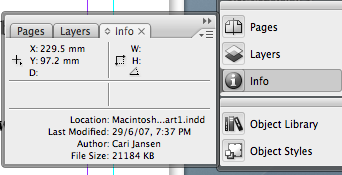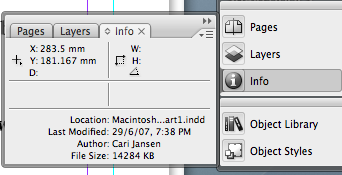Digitip 055 – Adobe InDesign CS3
This tip really isn’t Adobe InDesign CS3 specific. But is extended to anyone working on complex InDesign documents for hours on end.
After a long day’s work
InDesign’s Info Panel displays document information including file size when no artwork is selected on pages. The following screenshot was taken after about 15 hours of work on a single InDesign file.

As you can see the document size is signficant, around 21Mb. Each time you perform the File > Save command your document grows a little bit. The added changes are gradually accumulated. Over a longer period of time, this can have a significant impact on the file size of the InDesign document.
After Save As
At the end of the day, before closing this document performing a File > Save As and overwriting the existing file significantly decreases the file size of the document.

Immediately following the Save As on the above InDesign CS2 file shrunk the filesize by 30% to around 14Mb.
So tip of the day: Don’t forget to perform a Save As every now and again. Your Info Panel will thank you for it.
Footnote: Have you ever noticed that the first time you ever save a document the dialog box says “Save As” and wondered why that is? Well think of it… Do you ever see a dialog box when saving your file? Nope, you don’t. So why develop a separate dialog box for “Save”, when really what you are doing the first time you save an Untitled document is performing “Save As”. You’re picking a save location and file name and possibly file format. Ok, there might not be another document to overwrite, but that is the only difference.
Leave a Reply